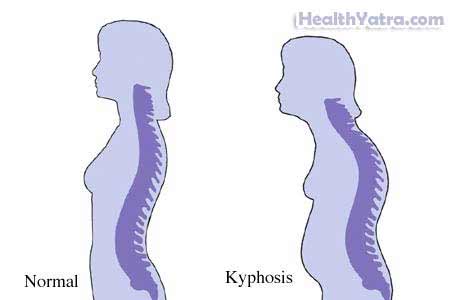Definition
Kyphosis is an abnormal rounding or curve to the spine. A certain degree of normal curve is seen in the spine. The abnormal kyphosis occurs in the thoracic spine (along ribs). The three main types of kyphosis are:
- Postural kyphosis—the most common abnormal type and is caused by bad posture
- Congenital kyphosis—a type that is present at birth
- Scheuermann’s kyphosis—a severe type that is genetic, but appears during the teenage years
If you think you or your child may have this condition, contact your doctor. Treatments may need to be started at a young age.

Causes
Kyphosis can start at any age. It can have various causes, including:
- Bad posture
- Arthritis
- Fractures of the vertebrae (bones in the spine)
- Trauma to the spine
- Osteoporosis
- Spine infection
- Certain diseases:
-
- Marfan syndrome
- Cerebral palsy
- Abnormal fetal development
- Unknown
Risk Factors
Factors that can increase your chance of getting kyphosis include:
- Marfan syndrome or other tissue disease
- Condition that weakens bones, like osteoporosis
- Age
-
- Adolescence for postural or Scheuermann’s
- Elderly with osteoporosis and spine fractures
- Sex
-
- Boys for Scheuermann’s kyphosis
- Girls for postural kyphosis
Symptoms
Tell your doctor if you have any of these:
- Excess curve or hump in the back
- Back pain
Diagnosis
Most cases can be diagnosed during a physical exam. Some cases are found at school during a scoliosis check. Your doctor will ask about your symptoms and medical history. A physical exam will be done to look for abnormal curve in the spine, rounded shoulders, and a hump on the back. Your doctor may refer you to a specialist in spine problems.
Your doctor may need pictures of your spine. This can be done with X-rays or other imaging tests.
Your doctor may need to measure how well you breathe. This can be done with pulmonary function tests.
Treatment
Talk with your doctor about the best plan for you. Options include the following:
Physical Therapy
Your doctor may refer you to a physical therapist to learn specific exercises. This may include strength work, stretching, and overall conditioning. You may also be taught how to maintain a correct posture. You may be instructed to sleep on a firm mattress.
Medications
Nonsteroidal anti-inflammatory drugs (NSAIDs) may be given for pain or discomfort. Medicine may be given to treat any other conditions, like osteoporosis.
Back Brace
Braces are sometimes used. They can help correct kyphosis or reduce discomfort.
Surgery
Surgery is reserved for severe cases. The spine is straightened by fusing the back bones (vertebrae) together. Surgeons may use bone from the pelvis to fuse the back bones. A metal rod may also be inserted into the spine to help straighten it.
Vertebral compression fractures, a cause of kyphosis, is sometimes treated with special cement. The cement is injected into the back bones affected.
Prevention
To help reduce your chance of getting kyphosis, take the following steps:
- Seek treatment for any bone diseases like arthritis and osteoporosis.
- Pay attention to your posture and avoid slouching.
